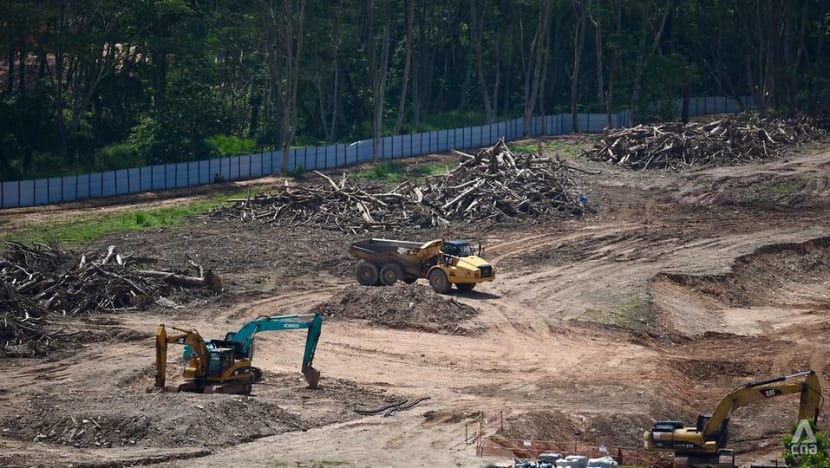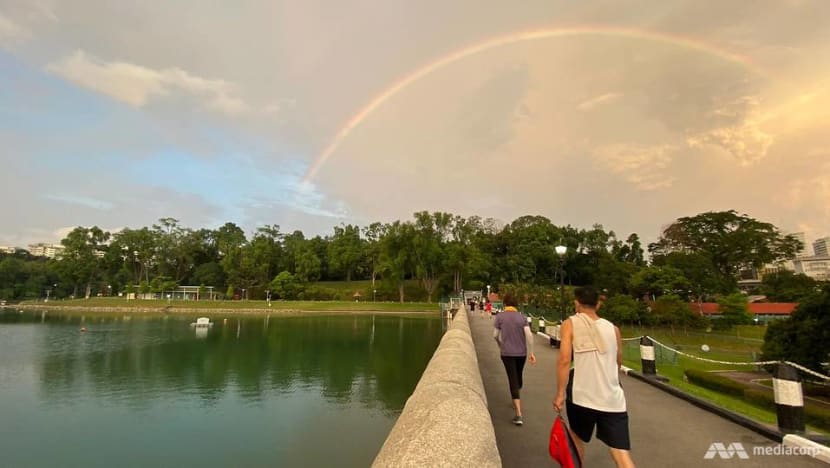commentary Commentary
Commentary: The awkward adventures of a Singaporean urbanite in a city in nature
Singaporeans really love nature, but the majority of us probably love the idea of nature more than its reality, says CNA’s Erin Low.

People wearing face masks at East Coast Park on Jul 19, 2020. (Photo: Try Sutrisno Foo)
SINGAPORE: Inspired by the online buzz around Clementi Forest, I decided late last year to venture into the thick of it all.
My interest was piqued by the prospect of finding the Jurong Railway – an offshoot of the train tracks that used to run from Woodlands to Tanjong Pagar, but since abandoned in the 1990s and overgrown with vegetation.
Feeling confident after consulting a few blogs and YouTube videos, I located the entry behind a bus stop, walked through a cavernous tunnel and emerged into dense undergrowth.
READ: Going wild about nature: Long walks around Singapore an alternative to overseas travel
The tracks formed a narrow path that sliced through the forest, but shrubs and haphazardly strewn logs made the walk somewhat of an obstacle course.
The afternoon rain also made it incredibly marshy. Many disgruntled explorers may have realised this. They were walking the other way while I was just beginning my hike.
After squelching through enough mud, fighting it as it sucked in my shoes with each step, I too decided to call it quits.
I took a few photos then turned and left. I probably got in only about 100m.
READ: Commentary: My walk around Singapore was a step outside my comfort zone - and I’m all the better for it
URBANITES THROUGH AND THROUGH
I wish I tried harder. Maybe it’s just me, but it seems while Singaporeans really love nature, the majority of us probably love the idea of nature more than its reality.

The passion Singaporeans have for our forests has been clear in recent months. Netizens were up in arms over the erroneous clearing of Kranji woodland by a JTC contractor.
Prior to that, some signed online petitions calling for the conservation of Clementi and Dover forests, areas both zoned for residential development.
Dover Forest in particular was subject to more immediate plans for redevelopment. The Housing Development Board announced it will offer 17,000 Build-to-Order flats this year. A few will be located in the Ulu Pandan estate, which is also home to Dover Forest.
But at the urging of the public and a few Members of Parliament, the Government announced it will extend the period for public consultation over Dover Forest’s fate.
READ: Commentary: Saving Dover Forest and the plight of the Singapore urban planner
(Could conserving green spaces lead to more wildlife encounters? Conservationists and an NParks director weigh in on Heart of the Matter:)
It’s heartening to see Singaporeans care about conserving green spaces, paving the way towards more inclusive, robust dialogue over these issues. A shift in our national approach has taken root.
But while much of our desire to safeguard forests is driven by the desire to enjoy them, much of the professional advice is to avoid these places – and for good reason. Last week, the Singapore Land Authority and National Parks Board (NParks) said Clementi and Dover forests “are not areas that are managed for recreation and public access”.
Citing uneven terrain, absence of paths and risks of falling trees or snapped branches, the agencies reminded the public “to be mindful of these dangers for their own personal safety”.
Beyond these hazards, there have been downsides to overcrowding at nature reserves. According to NParks, Bukit Timah Nature Reserve received 75,000 visitors in November 2020, more than double the average of 33,000 for November over past years.

While nature groups have applauded this surge of interest in our national parks, some hikers reported trails widening from overuse, with vegetation on the sides getting trampled on.
There have also been signs of visitors straying from designated paths, which could damage the forest floor and endanger plant saplings.
It turns out our adventures into these places might risk doing harm, not only to ourselves but also to the nature we want to conserve.
READ: Commentary: Save forests or build 4-rooms? It’s not a zero-sum game
THE WILD SIDE OF NATURE
Our recent run-ins with wildlife also underscores we have some way to go in navigating this man-nature relationship.
Last Saturday, a wild boar injured two people, activating a 20-strong search party for it. The wild boar further injured another woman and an officer, before it was caught and put down.
NParks said illegal feeding or irresponsible discarding of food might cause aggressive behaviour in boars. By having access to human sources of food, wild boars are more likely to venture into urban areas and approach people for food.
READ: Commentary: Cute otters and pangolins get saved but are ugly animals a lost conservation cause?
Wildlife can also cause nuisances. Otters are beloved for their cuteness and novelty, but they’ve been facing growing opposition for their propensity for eating expensive koi fish – to the point that some have called for their culling.
Even trees are not spared from this discussion. As Singapore’s Green Plan 2030 outlined, the country aspires to be a City in Nature, and will plant 1 million more trees in the next decade.
There are also incidents of fallen trees causing obstructions on roads or property damage. These often trigger public calls for greater scrutiny into how trees are managed.
The Green Plan also promises to add 1000ha of green spaces and 160km of park connectors by 2030. But letting green spaces grow wild could complicate dengue control operations, as seen when grass-cutting ceased during the Circuit Breaker period from April to June 2020.
READ: Commentary: Let Singapore’s green spaces grow wild
CITY SLICKERS CAN APPRECIATE NATURE TOO
As Singapore transforms from a city in a garden to a city in nature, we’ll find ourselves grappling with new challenges.
But most urban planners and nature lovers will still say that those are massively outweighed by the benefits green spaces bring us: Space for recreational activities, psychological wellness and a sense of belonging, in addition to protecting forests for future generations.
And so Singapore should expect a greater focus going forward on conserving patches of nature.
READ: Commentary: The truth behind returning wildlife is less feel-good than you think
For some of us, perhaps the harrowing aspects of nature are minimised through manicured parks like the Botanic Gardens. In nature reserves, boardwalks and canopy walkways serve to distance us from mud and mosquitos.
The experience of visiting these highly-managed parks should not be discounted for us city slickers. They could spark an interest in nature, which could lead to more focused pursuits of activities like birdwatching or hiking, for which there are many dedicated groups here in Singapore.
And perhaps for some of us, appreciating nature doesn’t mean we have to be in the thick of it. In fact, it’s probably best left alone.
SIGN UP: For CNA’s Commentary weekly newsletter to explore issues beyond the headlines
Erin Low is Research Writer for the Commentary section. She also works on CNA podcasts Heart of the Matter and The Climate Conversations.












